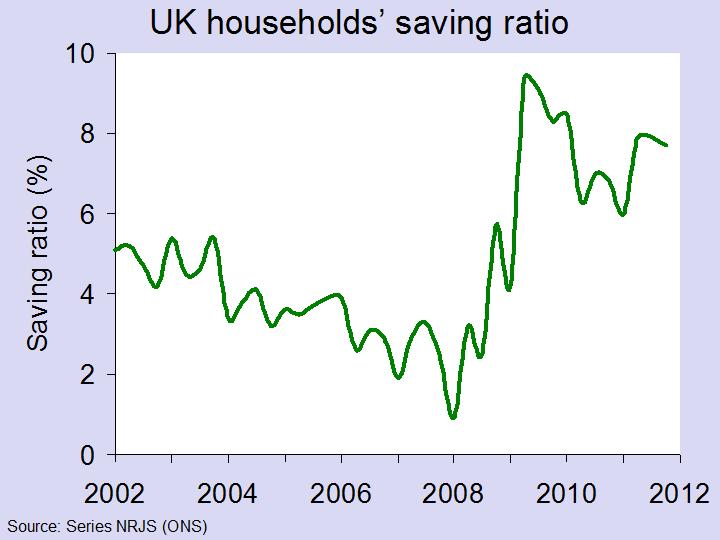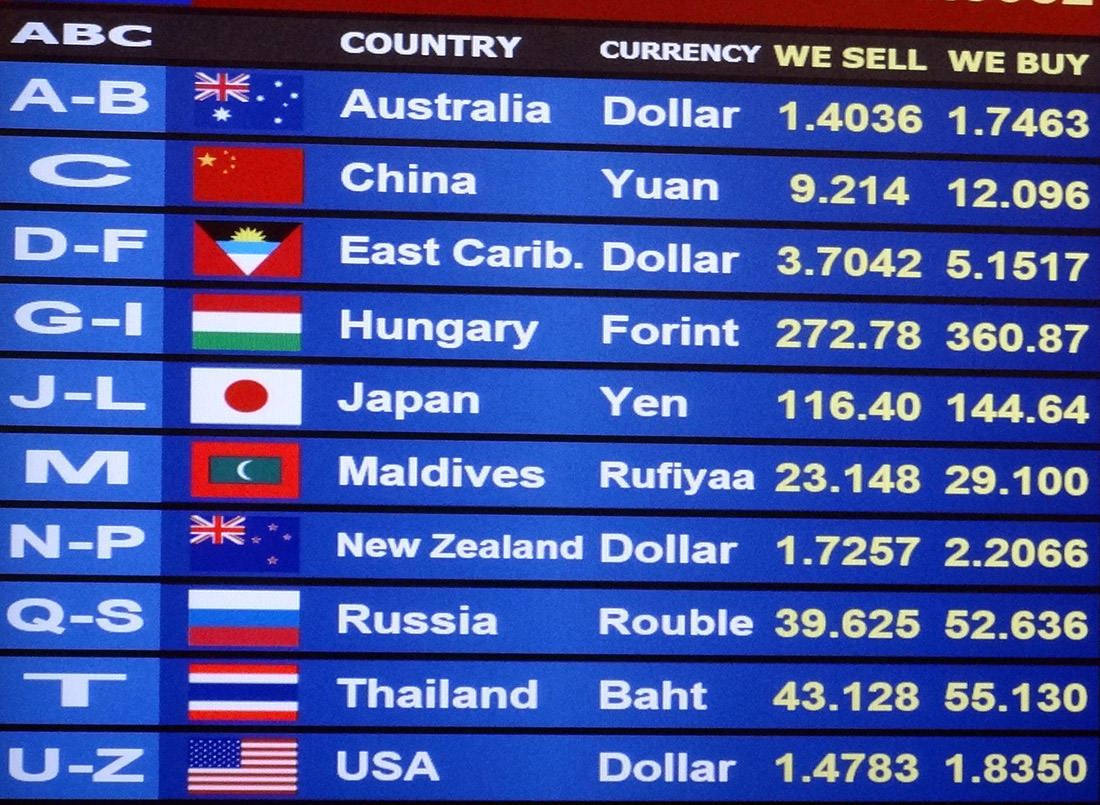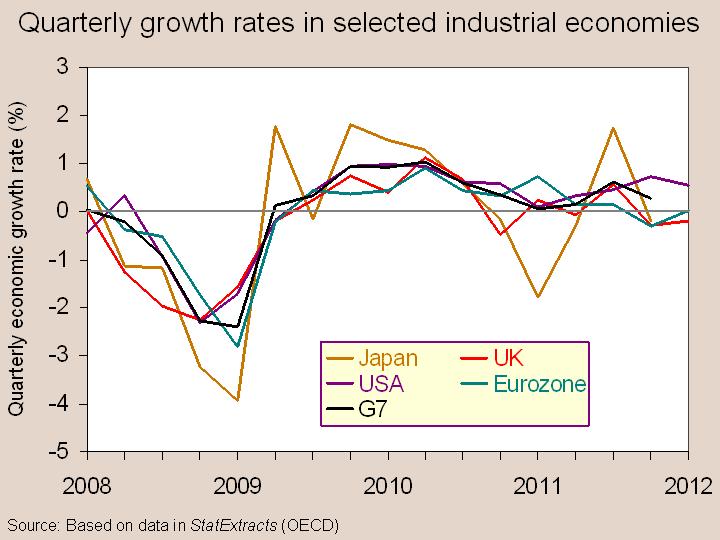 If one person saves more, then it will increase that person’s consumption possibilities in the future. If, however, everyone saves more, and hence spends less, then businesses will earn less and are likely to respond by producing less if the decline in aggregate demand continues. Hence if a country saves more, people could be worse off. That’s the paradox of thrift.
If one person saves more, then it will increase that person’s consumption possibilities in the future. If, however, everyone saves more, and hence spends less, then businesses will earn less and are likely to respond by producing less if the decline in aggregate demand continues. Hence if a country saves more, people could be worse off. That’s the paradox of thrift.
There is considerable debate around the world at the moment about the desirability of austerity policies. The debate has become more intense with the worsening economic outlook in many European countries and with the election in France of François Hollande who rejects many of the austerity measures of his predecessor, Nicolas Sarkozy.
 But can further stimulus be given to aggregate demand without causing a further worsening of countries’ public-sector debt positions and causing a fall in confidence in financial markets? And how would that impact on investment?
But can further stimulus be given to aggregate demand without causing a further worsening of countries’ public-sector debt positions and causing a fall in confidence in financial markets? And how would that impact on investment?
And in the meantime, as the economic outlook darkens, people are trying to save more, despite low interest rates. The paradox of thrift seems to be getting more acute. (Click here for a PowerPoint of the chart.)
Articles
How National Belt-Tightening Goes Awry New York Times, Robert J. Shiller (19/5/12)
Japan disease is spreading: High risk and low returns Firstpost (India), Vivek Kaul (17/5/12)
The Solution can not be More Debt Huffington Post, Jill Shaw Ruddock (29/5/12)
Crediting debt Breaking Views, Edward Hadas (30/5/12)
Green investments can overcome the paradox of thrift New Statesman, Dimitri Zenghelis (7/6/12)
Austerity has never worked Guardian, Ha-Joon Chang (4/6/12)
The False Choice Between Austerity And Growth Forbes (24/5/12)
It’s not a case of austerity v stimulus for Europe Guardian, Paul Haydon (1/6/12)
Data
UK households’ saving ratio: series NRJS ONS
Household saving rates for OECD countries StatExtracts: OECD
Questions
- Why may we be experiencing a paradox of thrift at the current time?
- What are the arguments for the use of fiscal and monetary policies to expand aggregate demand at the current time?
- What are the arguments against the use of fiscal and monetary policies to expand aggregate demand at the current time?
- Can economic growth be stimulated by a redistribution of aggregate demand and, if so, in what way?
- Can green investment overcome the paradox of thrift?
- To what extent are demand-side and supply-side policies (a) complementary; (b) contradictory? Or, to put the question another way, to what extent may policies to encourage growth in the long term damage growth in the short term and vice versa?
 With tight incomes, the first things that families tend to cut back on are the more luxury items. Extensions to houses are delayed, interior refurbishments are put off and the old car that was going to be traded in becomes something you can live with for another few years.
With tight incomes, the first things that families tend to cut back on are the more luxury items. Extensions to houses are delayed, interior refurbishments are put off and the old car that was going to be traded in becomes something you can live with for another few years.
Car sales have been adversely affected during the recession, but data for May 2012 show a positive turn. Manufacturers have said that car sales are up by 7.9% compared with May last year. According to the Society of Motor Manufacturers and Traders (SMTT), much of the increased demand has come from private sales, where the increase has been over 14%.
This data may not be the answer to the economic troubles, but it is perhaps an indication that confidence is beginning to return. However, should things go from bad to worse in the eurozone, it isn’t hard to see data for the coming months showing the opposite trend. One other key piece of information to take from this data is the growth in the sales of lower-emissions vehicles. Sales of these were up 31.8% in May 2012 compared to the same time last year. Jonathan Visscher from SMMT said:
‘The green sector is growing fast…Every car manufacturer is going to have a hybrid model on its lists by the end of this year, even Ferrari.’
The continuing upward trend in car sales is by no means guaranteed to continue, especially with things like the expected rise in fuel duty later this year and the ongoing crisis in the eurozone, with Spanish banks potentially looking for help via a bail-out in the not too distant future. The following articles consider the acceleration in car sales.
UK sees biggest annual rise in car sales for nearly 2 years Reuters (8/6/12)
New car sales accelerate ahead Press Association (8/6/12)
UK new car sales accelerated in May, say manufacturers BBC News (8/6/12)
New car sales accelerate ahead Independent, Peter Woodman (8/6/12)
Car registrations accelerate in May Financial Times, John Reed (8/6/12)
Questions
- How would you define a luxury good? What is the relationship with income?
- How could an increase in car sales benefit the economy? How could the multiplier effect have an impact?
- Which factors have contributed towards the growth in low-emissions cars?
- Sales of low-emissions cars have significantly increased. However, why is this increase
- What are some of the key things that can help to bring a recession to an end? Into which general category would you place this increase in car sales?
- Fuel duty is expected to rise later this year. How might this affect the number of new car registrations? What does your answer tell you about the cross elasticity of demand?
 Paul Volcker was Chair of the US Federal Reserve from 1979 to 1987. He was also Chair of the Economic Recovery Advisory Board under President Barack Obama from February 2009 to January 2011. In the webcast and articles below, he reflects on the current state of the world financial system – from regulation, to the euro crisis, to world imbalances, to the system of floating exchange rates.
Paul Volcker was Chair of the US Federal Reserve from 1979 to 1987. He was also Chair of the Economic Recovery Advisory Board under President Barack Obama from February 2009 to January 2011. In the webcast and articles below, he reflects on the current state of the world financial system – from regulation, to the euro crisis, to world imbalances, to the system of floating exchange rates.
He argues that global financial systems are vulnerable to breakdowns. What is needed is reform to the system, and for that there needs to be consensus by politicians, regulators and central banks.
But, in the absence of international consensus on some key points, reform will be greatly weakened, if not aborted. The freedom of money, financial markets and people to move – and thus to escape regulation and taxation – might be an acceptable, even constructive, brake on excessive official intervention, but not if a deregulatory race to the bottom prevents adoption of needed ethical and prudential standards.
Perhaps most important is a coherent, consistent approach to dealing with the imminent failure of “systemically important” institutions. Taxpayers and governments alike are tired of bailing out creditors for fear of the destructive contagious effects of failure – even as bailouts encourage excessive risk-taking.
According to Volcker, countries must be prepared to surrender some sovereignty. Policies must be co-ordinated internationally and there must be stronger regulation by international bodies, such as the IMF and stronger concerted action by global organisations, such as the G20.
 Left to their own devices, in an era of floating exchange rates, countries may pursue policies that exacerbate global imbalances.
Left to their own devices, in an era of floating exchange rates, countries may pursue policies that exacerbate global imbalances.
Not so long ago, we were comforted by theorising that floating exchange rates would mediate international adjustments in a timely and orderly way. But, in the real world, many countries, particularly but not limited to small, open economies, simply find it impractical or undesirable to permit their currency to float.
We are left with the certainty, however awkward, that active participation in an open world economy requires some surrender of economic sovereignty. Or, to put the point more positively, it requires a willingness to co-ordinate policies more effectively.
Webcast
 Volcker Urges Global Monetary System Overhaul BloombergBusinessweek (31/5/12)
Volcker Urges Global Monetary System Overhaul BloombergBusinessweek (31/5/12)
Articles
Is global financial reform possible? Guardian, Paul Volcker (6/6/12)
Volcker Urges Global Financial System Overhaul After Crisis BloombergBusinessweek, Robyn Meredith and Shamim Adam (31/5/12)
Questions
- What reforms, according to Volcker, need to be implemented in order for the euro to function effectively without crises?
- What can the USA do to ease the euro crisis?
- What are Volcker’s views on the regulation of the US banking system?
- How are incentive structures in banks related to speculative activities?
- Should banks be allowed to fail?
- What financial imbalances exist between countries?
- What international monetary reforms are required?
- What light can game theory shed on the difficulty of achieving global policy co-ordination?
- Is an international system of floating exchange rates appropriate given the size of international financial flows?
 Calls for a simplified tax and benefit system have been ongoing and many see the Coalition’s plans for a Universal Credit as a step in the right direction. However, a second suggestion set out in a report by lobbying groups is to introduce a single rate of income tax at 30%. The argument is that it will simplify the system, help lower income earners and boost growth.
Calls for a simplified tax and benefit system have been ongoing and many see the Coalition’s plans for a Universal Credit as a step in the right direction. However, a second suggestion set out in a report by lobbying groups is to introduce a single rate of income tax at 30%. The argument is that it will simplify the system, help lower income earners and boost growth.
As well as the introduction of a single rate of income tax, The 2020 Tax Commission’s Report also suggests an increase in the personal allowance to £10,000; scrapping National Insurance Contributions, stamp duty, inheritance tax and air passenger duty, as well as cutting fuel duty by 5p. For the typical tax payer, it may sound great – the difference between your gross and your net pay would narrow, but the wider consequences must be considered. Although a single rate of income tax would undoubtedly simplify the system, the impact on government finances must be considered. The commission predicts that overall borrowing would fall by £35bn after 15 years, but that the national deficit would increase by £49.1bn in the first year. Perhaps not an ideal solution given the current state of the national deficit!
The report does contain some radical change, but the idea of simplification is well-recognised as a necessary principle of any tax system. As the Chairman of the Commission, Allister Heath said:
It is time for Britain to make a vital choice between tweaking the status quo and letting our economy continue to be crippled by complex and punitive taxes, and drastically changing course with a radical but realistic plan for a tax system fit for the 21st century.
The 2020 Tax Commission has set out that plan and would ensure that income is taxed once at a single, much more reasonable rate. It could create the conditions to establish the UK as a global trading hub, generating renewed prosperity for all those who live and work here.
The current system is complex and many people end up paying an extremely high rate of tax, once everything has been paid. The Guardian article below gives a nice illustration. “If you earn income from shares, first corporation tax is taken out of the profits. Then you pay taxes on the dividends. Then because those profits drive up the share price you pay capital gains tax as well.” With a simpler and fairer tax system, the Commission argues that it will boost the competitiveness of the UK economy and help boost its struggling growth rate. How many, if any, of these proposals will be incorporated into the government’s plans is anybody’s guess, but it definitely presents an interesting solution and problem.
Report
The Single Income Tax The 2020 Tax Commission (May 2012)
Articles
Why it’s time for a single income tax Guardian, Matthew Elliott (21/5/12)
Business backs income tax rate of 30% Financial Times, Martin Sandbu (21/5/12)
Calls for single 30% income tax rate BBC News (21/5/12)
Single 30% tax rate ‘essential’ for growth Sky News (21/5/12)
Osborne urged to introduce 30pc income tax for all The Telegraph, Tim Ross (20/5/12)
Tax shake-up urged to empower consumers and kickstart growth Independent, Russell Lynch (21/5/12)
The Tax Reform Britain needs Wall Street Journal, Matthew Sinclair (20/5/12)
Questions
- What are the key principles of a tax system?
- Explain why simplicity is so important when reforming a tax system. How can it affect the incentive to work?
- Would a 30% single rate of income tax be equitable?
- If the reforms set out in the report were to go ahead, what do you think would be the impact on goods and services provided by the government, such as the NHS, education, roads?
- Using indifference analysis, illustrate the effect of a cut in the basic rate of income tax. How does it affect the decision to work more or less? You should consider the income and substitution effects in your answer.
- Why does the report argue that the reforms they suggest would help boost growth?
- How might the proposals affect government finances in both the short and long term?
 In the third and final part of this blog, we look at the G8 summit at Camp David on 18 and 19 May 2012. Ways of averting the deepening global economic crisis were top of the agenda.
In the third and final part of this blog, we look at the G8 summit at Camp David on 18 and 19 May 2012. Ways of averting the deepening global economic crisis were top of the agenda.
In terms of the global economy, the leaders agreed on three main things. The first was that they supported Greece remaining in the euro. According to the communiqué:
We agree on the importance of a strong and cohesive eurozone for global stability and recovery, and we affirm our interest in Greece remaining in the eurozone while respecting its commitments. We all have an interest in the success of specific measures to strengthen the resilience of the eurozone and growth in Europe
The second was a commitment to ‘fiscal responsibility’ and the clawing down of public-sector deficits.
We commit to fiscal responsibility and, in this context, we support sound and sustainable fiscal consolidation policies that take into account countries’ evolving economic conditions and underpin confidence and economic recovery.
 The third was commitment to boosting economic growth. (Click on chart for a larger image.) On the supply side this would be through measures to stimulate productivity. On the demand side this would be through policies to stimulate investment.
The third was commitment to boosting economic growth. (Click on chart for a larger image.) On the supply side this would be through measures to stimulate productivity. On the demand side this would be through policies to stimulate investment.
(For a PowerPoint of the chart, click on the following link: Quarterly Growth.)
To raise productivity and growth potential in our economies, we support structural reforms, and investments in education and in modern infrastructure, as appropriate. Investment initiatives can be financed using a range of mechanisms, including leveraging the private sector. Sound financial measures, to which we are committed, should build stronger systems over time while not choking off near-term credit growth. We commit to promote investment to underpin demand, including support for small businesses and public-private partnerships.
But the communiqué was short on details. How will fiscal consolidation be achieved? Does this mean a continuation of austerity measures? And if so, what will be the impact on aggregate demand? Or if fiscal consolidation is slowed down, what will be the impact on financial markets?
If a growth in investment is central to the policy, what will be the precise mechanisms to encourage it? Will they be enough to combat the deflationary effect on demand of the fiscal measures?
And how will productivity increases be achieved? What supply-side measures will be introduced? And will productivity increases be encouraged or discouraged by continuing austerity measures?
Lots of questions – questions raised by the articles below.
Articles
Capitalism at a crossroads Independent (19/5/12)
 Barack Obama warns eurozone to focus on jobs and growth The Telegraph (20/5/12)
Barack Obama warns eurozone to focus on jobs and growth The Telegraph (20/5/12)
G8 Summit: World leaders push for Greece to stay in the eurozone The Telegraph, Angela Monaghan (19/5/12)
Obama sees ’emerging consensus’ on crisis Sydney Morning Herald, Ben Feller and Jim Kuhnhenn (20/5/12)
G8 leaders tout economic growth, fiscal responsibility CNN (20/5/12)
G8 focuses on Eurozone Gulf News (20/5/12)
G8 leaders back Greece amid tensions France 24 (20/5/12)
G8 splits over stimulus versus austerity Financial TimesRichard McGregor and Kiran Stacey (19/5/12)
Cameron is consigning the UK to stagnation Financial Times, Martin Wolf (17/5/12)
Time to end ‘Camerkozy’ economics Financial Times, Ed Miliband (18/5/12)
Obama: Eurozone ‘must focus on jobs and growth’ BBC News (20/5/12)
World leaders back Greece, vow to combat financial turmoil Reuters, Jeff Mason and Laura MacInnis (19/5/12)
Germany isolated over euro crisis plan at G8 meeting in Camp David Guardian, Patrick Wintour (19/5/12)
G8 leaders end summit with pledge to keep Greece in eurozone Guardian, Ewen MacAskill (19/5/12)
G8 summit ends with few tangible results Xinhua, Sun Hao (20/5/12)
Final communiqué
Camp David DeclarationG8 (19/5/12)
Questions
- To what extent are economic growth and fiscal consolidation (a) compatible; (b) incompatible objectives? How might a Keynesian and a new classical economist respond to these questions?
- What supply-side measures could be introduced by the EU?
- Why might dangers of protectionism increase in the coming months?
- What would be the impact of a Greek default and exit from the eurozone on other eurozone economies?
- What monetary policy changes could be introduced by the eurozone governments and the ECB in order to ease the sovereign debt crisis of countries such as Grecce, Spain, Portugal, Italy and Ireland?
 If one person saves more, then it will increase that person’s consumption possibilities in the future. If, however, everyone saves more, and hence spends less, then businesses will earn less and are likely to respond by producing less if the decline in aggregate demand continues. Hence if a country saves more, people could be worse off. That’s the paradox of thrift.
If one person saves more, then it will increase that person’s consumption possibilities in the future. If, however, everyone saves more, and hence spends less, then businesses will earn less and are likely to respond by producing less if the decline in aggregate demand continues. Hence if a country saves more, people could be worse off. That’s the paradox of thrift. But can further stimulus be given to aggregate demand without causing a further worsening of countries’ public-sector debt positions and causing a fall in confidence in financial markets? And how would that impact on investment?
But can further stimulus be given to aggregate demand without causing a further worsening of countries’ public-sector debt positions and causing a fall in confidence in financial markets? And how would that impact on investment?





